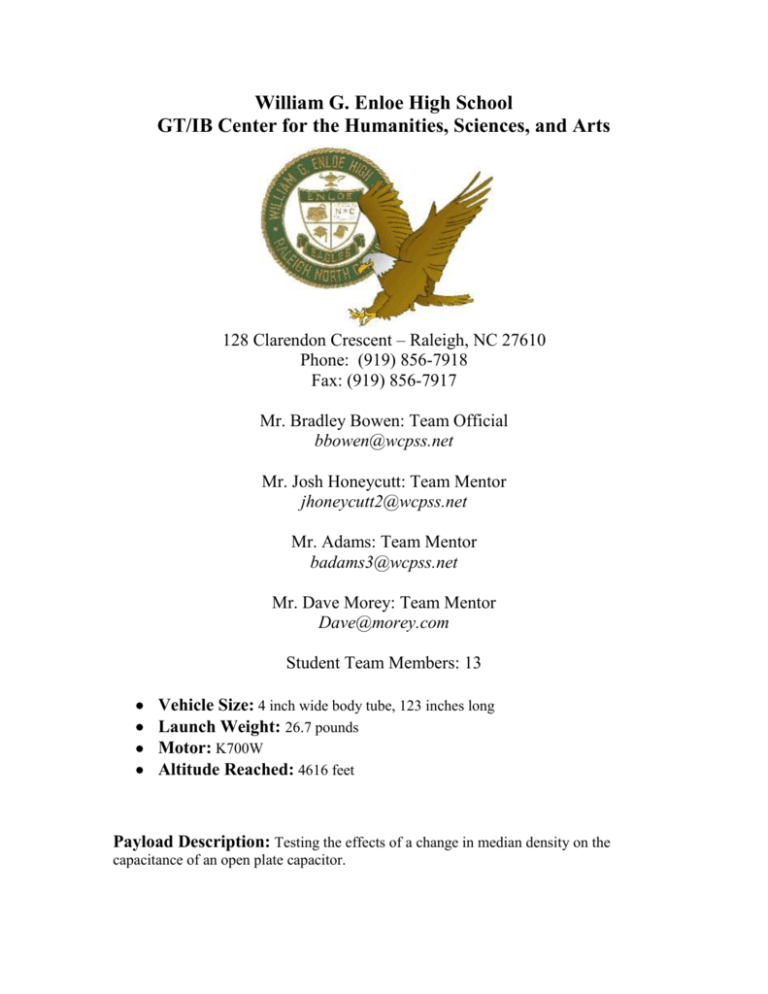William G
advertisement

William G. Enloe High School GT/IB Center for the Humanities, Sciences, and Arts 128 Clarendon Crescent – Raleigh, NC 27610 Phone: (919) 856-7918 Fax: (919) 856-7917 Mr. Bradley Bowen: Team Official bbowen@wcpss.net Mr. Josh Honeycutt: Team Mentor jhoneycutt2@wcpss.net Mr. Adams: Team Mentor badams3@wcpss.net Mr. Dave Morey: Team Mentor Dave@morey.com Student Team Members: 13 Vehicle Size: 4 inch wide body tube, 123 inches long Launch Weight: 26.7 pounds Motor: K700W Altitude Reached: 4616 feet Payload Description: Testing the effects of a change in median density on the capacitance of an open plate capacitor. Vehicle Summary: The majority of our rocket is made of fiberglass, with the exception of the bulkheads, nose cone, and motor mount. Sections that contain black powder charges have thicker bulkheads to prevent the charges from damaging them. Sections that are not supposed to separate are screwed together. 2 screws hold the nose cone and payload section. The nose cone houses our open plate capacitor, and the section under it holds the capacitance meter. This payload section is connected to the main parachute chamber, and two screws hold these two sections together also. The main parachute section connects to our dual deployment section, and shear pins hold the two together to help prevent their separation at apogee, when the drogue parachute is deployed. The dual deployment section features a door for easy access to the electronics while the rocket is set up. The dual deployment section connects to the drogue/engine section, and is friction fit to prevent premature separation. The engine section features a through-fin design, and four centering rings are used to secure the motor mount in the engine section. The centering rings closest to the fins are also used to help hold the fins in place. For our positive motor retention, we have three metal clips that have been screwed into the bottom centering ring on our motor mount, with a nut and epoxy on either side to increase their strength. A 30foot-long 1.5 inch Kevlar shock cord connects the payload to the dual deployment section (when the main parachute deploys) and a 1-inch shock cord between the dual deployment section and drogue/engine section (when the drogue deploys). These shock cords are connected to metal eyehooks, which are screwed through thick bulkheads, have nuts and washers on either side of the bulkhead, and have been covered in epoxy. We have chosen to use fiberglass, and other materials, because we feel confident that these materials will be strong enough to withstand the forces exerted on them during take-off and when the parachutes deploy. When designing our rocket, we selected section lengths that we felt that we would need, without a lot of extra space that we would have no use for. In the rocket, most of the space has a purpose, so extra materials aren’t wasted. The rocket is simply 4 inches wide, without any transitions, as we did not need wider sections. The fin design is one that we have used in the past due to its simplicity and sturdiness. After completing the construction of our rocket, places with epoxy, especially on the outside of the rocket and around the fins, have been sanded and smoothed out to prevent extra drag and to make the rocket neat and easy to work with. Our rocket has successfully flown twice (test launch and Huntsville launch) and has taken only slight damage to a coupler. It reached an altitude of 4757 feet during our test launch (without a complete payload, but extra weight added to the payload section to make up for this) and 4616 feet during our Huntsville launch. During both flights no wobble was visible. Drogue parachutes successfully deployed at apogee and main parachutes deployed at 500 feet, taking almost no damage from the charges. During our test launch, the battery for one of our two dual deployment altimeters came out when the drogue deployed, causing only one charge to eject our main parachute. We therefore secured the batteries with tape in addition to the clips that we were using. Payload Summary/results: Our payload consists of an open plate capacitor, located in the nosecone, and a capacitance meter in the section under the nosecone, a camera that observes the capacitance meter’s readings, and a light. As the rocket ascends and descends, the air density changes. Our payload is designed to test the effects of this change in air density on capacitance. The capacitance meter has the ability to measure .1 picofarads. We were originally planning on building a circuit, which required a data logger that reads DC voltage. Unfortunately we had difficulty finding such a data logger that would fit in our rocket. Since we had the same trouble with a data logger that records capacitance, we purchased a capacitance meter and used a camera to observe the readings. Our results showed very little, and random changes in capacitance throughout the rocket's flight. The capacitance was most often within a range of 23.2pF and 23.9pF. A number of things could be responsible for such results, whether it be the way that the experiment was conducted, or the change in air density having very little or no affect on the capacitance. The few changes in capacitance can be explained by the shacking of the rocket, as we saw during tests that vibration and movement has a great affect on the output of the capacitance meter. Following this assumption, we could hypothesize that the lift off of our rocket, drogue separation, and main parachute separation are responsible for some of the spikes seen in our data. The following is a plot of readings of capacitance vs. altitude: Pictures from launch (only ascent): Scientific Value: This flight can contribute to the scientific community in various ways. For one, our team observed solely based off of the single flight, that capacitance remains consistent throughout the flight. Although this experiment requires further testing to make an ultimate conclusion, the results of our test clearly show that electronics can be onboard a vehicle increasing in altitude with out having a significant effect. Additionally, this can affect future testing in why there are sudden spikes in capacitance when separation in a vehicle occurs. Although our results didn’t show any exciting new breakthroughs and didn’t concur with our original hypothesis, it gave clear evidence that the change in capacitance is negligible and electronics on board an air-vehicle don’t pose a danger. Visual Data: The actual flight of the rocket went as planned. The rocket experienced what appeared to be no wobble during its ascent, both parachutes deployed as expected, and the rocket came down safely. We did not find any damage to the payload that could have influenced our experiment's results. Lessons Learned: Our team began the project with an idea for an experiment, which we later abandoned due to its difficulty and our uncertainty that it would work. As a result, we had lost a month. Since the early days of this project, we have been having trouble meeting the deadlines that we set for ourselves. Being a month behind put us on a tighter schedule and forced us to work more efficiently. As a result, we learned the importance of teamwork and time management in order to maximize efficiency. Summary of overall experience: Although the data that we gathered did not support our hypothesis that we would see an increase in capacitance as the air density decreases, we all had the chance to build a rocket with an experiment, and later analyze the data gathered; a process similar to what jobs will require in the future. This project presented us with various challenges and problems that we would have to get around. Through planning and testing we were able to defeat these problems and construct a 10-foot-tall high-powered rocket and send it approximately a mile high. This project exposed every member of the team to the type of environment that many careers will offer, as far as working with teams and solving problems. Such an experience will have a positive affect on team members whether they decide to go into engineering or not. Educational Engagement: On May 19th we visited Douglas Elementary School to educate some students about rocketry. A total of 93 k-5th graders were present. After discussing the different aspects of rocketry, including safety, rocket modeling with computers, constructing the rockets, and about our experience with SLI, we divided the kids into 3 groups. We then constructed a few small rockets which would fly 100 feet. After that, we launched a 2 foot rocket to 200 feet on an f-20 motor for the kids to see. We ensured safety by keeping the kids at a safe distance from the launch site. We are currently in the process of designing a 2 stage 3 foot tall rocket for another outreach program – Cary Space Camp. We will visit the space camp a number of times this summer to teach the kids about rocketry.








